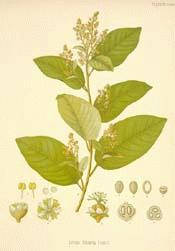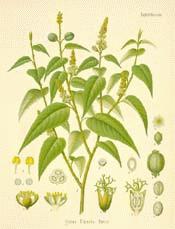
CascarillaBotanical: Croton Eleuteria (J. BENN.)
---Synonyms---Sweetwood Bark. Sweet Bark. Bahama Cascarilla. Elutheria. Clutia Eleuteria. Cascarillae Cortex. Cortex Thuris. Aromatic Quinquina. False Quinquina.
|

|
(Croton Eleuteria) |
---Description---It is a small tree rarely reaching 20 feet in height, with scanty, alternate, ovate-lanceolate leaves, averaging 2 inches long, closely-scaled below, giving a metallic silver-bronze appearance, with scattered, white scales above. The flowers are small, with white petals, and very fragrant, appearing in March and April. The scented bark is fissured, and pale yellowish brown. It is imported from Nassau, in New Providence.
The quills of dried bark average 2 inches in length, and 3/8 inch in thickness. They are often furrowed in both directions, so that they appear to be chequered. The outer, thin, corky layer is white, often covered with a fine lichen ( Verrucaria albissima). The second layer is brownish, and sometimes shows through. The bark is hard and compact, breaking with a short, resinous fracture. The taste is nauseating, warm and bitter, and the odour agreeable and aromatic, especially when burned, resembling weak musk, so that it is used in fumigating pastilles, and sometimes mixed with tobacco, though in the latter case some regard it as being liable to cause giddiness and symptoms of intoxication.
The leaves can be infused for a digestive tea, and the bark yields a good, black dye.
[Top]
---Constituents---There have been found in the bark albumen, tannin, cascar illin (a bitter, crystallizable principle, soluble in alcohol, ether, and hot water), red colouring matter, fatty matter with a sickly odour, volatile oil, gum, wax, resin, starch, pectic acid potassium chloride, a salt of calcium, and lignin.
The oil contains an alcohol, two sesquiterpenes, a free acid consisting of liquid cascarillic acid and a mixture of solid palmitic and stearic acids, eugenol, a terpene (differing from pinene), cymene, and possibly some l-limonene. Betaine has also been found.
---Medicinal Action and Uses---An aromatic, bitter tonic, with possibly narcotic properties. It is used in dyspepsia, intermittent and low fevers, diarrhoea and dysentery. It is a stimulant to mucous membranes, and in chronic bronchitis is used as an expectorant; while it is valuable in atonia dyspepsia, flatulence, chronic diarrhcea, nocturnal pollutions, debility and convalescence. Added to cinchona, it will arrest vomiting caused by that drug.
---Dosages---Of Cascarilla powdered Bark, 20 to 30 grains. Of Infusum Cascarillae (B.P. 1 OZ. to 1/2 pint), 1 to 2 fluid ounces. Of Tinctura Cascarillae, 1/2 to 2 fluid drachms. Of fluid extract, 1/2 to 1 fluid drachm. Tincture, B.P. 1/2 to 1 drachm.
---Other Species---
Cascarilla is also the name of Quina morada, the bark of Pogonopus febrifugus, used in the Argentine Republic as a substitute for cinchona bark. An alkaloid, Moradeine, and a blue fluorescent substance, Moradin, have been separated from it.
Croton Cascarilla, the Wild Rosemary of the West Indies, was at first thought to be the source of the Cascarilla of commerce.
C. Pseudo-China, or Copalchi Bark, of Mexico, also known as Copalche Bark or C. niveus, resembles C. Eleuteria so closely that it can be mistaken for it. It is used in the same way. A second variety, more bitter, may be a product of C. suberosus.
It has also been mistaken for a variety of cinchona.
C. micans is thought to have similar properties.
White, red, and black Cascarillas are also found in commerce, differing in form and properties, but these are other names for varieties of quinquina.
[Top]
© Copyright Protected 1995-2004 botanical.com

|
| GuestBook |
STUMBLE-UPON: NATIVE AMERICAN EMBASSY: HOME PAGE:

|
Copyright(s) © 1991-2012: Lenni Lenape Phoenix, Native American Embassy, Mandy & NATIVE ENIT, Native American Holocaust Museum, Inc., Minister Jessie Renee (Von Noaker) ThunderWolfe, Priscylla Belle Venticello, Von Noaker Family Publishing Group International North American Homeless Ombudsman Council
Copying in any form or medium is strictly forbidden without prior written permission: Illegal copying (Taking Possession of) anything within this Web Domain contitutes "Criminal Theft of (Intelectual) Property & will be treated as such! |
|
|
|
VISITOR STATISTICS: TREEPAD
|
|
CONTACT INFORMATION: NATIVE AMERICAN EMBASSY 1413 Union Avenue McKeesport, Pennsylvania 15132 USA PHONE: [VOICEMAIL ONLY HOTLINE (News, Reports, etc.)]: (412) 436-3866 Pennsylvania, Pittsburgh Office: (412) 689-9051 Pennsylvania, Johnstown Office: Private: Auto Transfers To Hawaiian Office HAWAIIAN OFFICE & MAIN NORTH AMERICAN (U.S.) OFFICE: (808) 445-6576 NEW YORK OFFICE: (631) 913-3475 OKLAHOMA OFFICE: (405) 225-6124 |
|
